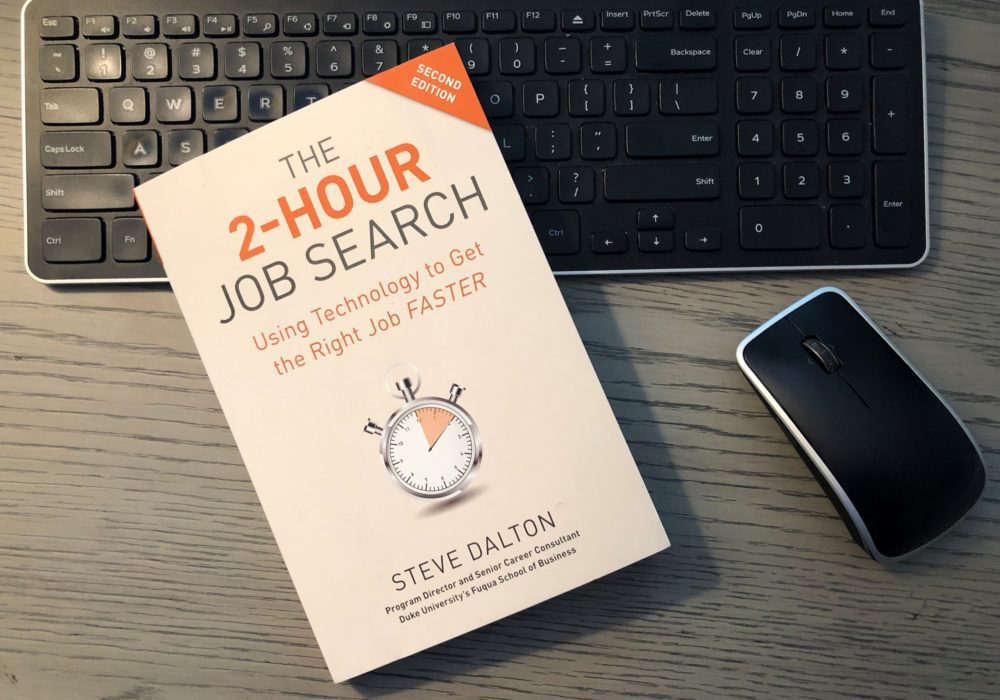In January, Darden hosted a webinar for students with Steve Dalton, career coach and author of The 2-Hour Job Search: Using Technology to Get the Right Job Faster. My inner cynic couldn’t help but wonder how a job search could be executed in two hours, especially if it takes a three-hour webinar to describe the process, but I had heard of the book and was intrigued.
So, can you find a job in two hours? Spoiler alert: No. Dalton clarifies early on that “the titular two hours refers to the amount of time it takes to lay the groundwork for your process, not the totality of your job search.” In my estimation, even the groundwork estimate is overly aggressive for most. The book makes big assumptions about one’s readiness for a job search. However, the book provides some good insights about effective and ineffective search techniques, it provides great frameworks for job search processes that many job seekers find nebulous, and (my personal favorite) it encourages a bias for action.
No More Cold Online Applications
Dalton provides compelling evidence for why randomly applying for jobs online is a “fool’s errand.” While this is not a novel concept, it bears repeating, because most job seekers tend to do it anyway. Dalton references a study of hiring at the New York Federal Reserve in which 12 out of every 13 jobs posted were filled through internal referrals rather than online applicants. Every career coach and nearly all successful job seekers will confirm that targeted networking is the key to securing your next job.
There’s a Framework for That
The 2-hour job search method has three primary components and offers three corresponding frameworks for each:
- Developing a target list of companies (“The LAMP List”)
- Identifying and connecting with people at those target companies (“Contact”)
- Using informational conversations to convert these contacts into advocates who will ultimately refer you (“Convince”).
Dalton references some terrific resources, all free, for developing a target list of companies. He teaches you to use LinkedIn and other web-based tools in ways you didn’t know were possible. Additionally, many readers will appreciate the concrete approaches for networking processes, which can elude even the most personable, self-aware job seekers. Dalton answers questions such as:
- “Who should I reach out to at company xyz?”
- “What should my email say?”
- “How many times should I follow up?”
His rational, flow-chart-like style eliminates the guess work and also tempers emotional decision-making and feelings of rejection. It’s a numbers game and you will waste exactly zero time on people that are not going to help you.
So, Is This Book for Me?
Darden’s Alumni Career Services 5-step job search model, and the steps in which the 2-hour job search frameworks apply, is depicted below.
I find that for many job seekers, Step 1, determining your career objective, is the hardest and most time-consuming step. The 2-hour job search method makes the assumption that you have already figured this out. It would be difficult to successfully execute the “Contact” and “Convince” stages of the 2-hour job search approach if you are unclear about what you are looking for. In general, I would recommend using the book as a supplement in the Market Research and Networking phases of your search, if you find yourself stuck in either of these areas. If reaching out to potential employers feels awkward and overwhelming, The 2-Hour Job Search can help you start moving forward.
If you are a Darden alum in transition or looking to make a career change, the Armstrong Center for Alumni Career Services is here to help. Reach out to us to schedule a session with a career coach.






